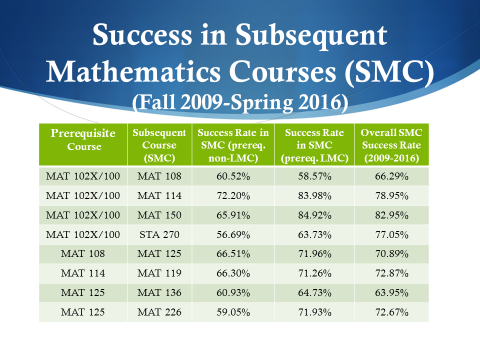Last week I published three e-Literate TV episodes on Northern Arizona University and their suite of initiatives aimed at helping first-year (and often first-generation) students. In those videos, NAU staff made some interesting claims, in particular that they are seeing improved student performance in subsequent courses after students take one of their modified emporium math courses in the Lumberjack Mathematics Center.
(YouTube playlist: http://bit.ly/etv_NAU)
(Video source specific claim: http://bit.ly/NAU_SMCclaim)
I asked NAU faculty and staff if they could provide data backing up this claim (this is not the first time we’ve asked for data as part of our case studies with e-Literate TV).1 And kudos to NAU, they did provide data describing this situation.
The following chart shows student success rates (percentage of students passing the course) based on 8 years of data, as follows:
- LMC = Lumberjack Mathematics Center such that “prereq. LMC” / “prereq. non-LMC” shows whether the prerequisite course did or did not use the current modified emporium approach, respectively
- MAT 102X was the pre-LMC Intermediate Algebra course that was replaced by MAT 100 Math Pathways LMC course
- MAT 108 is Algebra for Precalculus in LMC
- MAT 114 is Quantitative Reasoning in LMC
- MAT 125 is Precalculus in LMC
- MAT 150 is Principles of Mathematics I (the first of two math content courses required of Elementary Education majors)
- STA 270 is Introduction to Statistics
- MAT 119 is Finite Mathematics
- MAT 136 is Calculus I
- MAT 226 is Discrete Mathematics
- Overall SMC Success Rate shows all students, whether they had to take the prerequisite or not
The following summary includes my interpretation and description, but NAU faculty and staff did help with describing the data and results. Some qualifications are in order here:
- This is internal data and has not gone through peer-reviewed research methods, so treat the data as strong indications of success but not as proof that modified emporium is the primary reason for differences. For example, NAU has improved its advising and student support as described in episode 2, and we don’t know how those improvements affect the outcomes. Or treat the data as backing up claims made in the video interviews.
- Most students taking MAT 100, 108, 114, and 125 are in the LMC (modified emporium); to account for columns 3 and 4, NAU researchers looked at a combination of pre-LMC course data and the smaller number of more recent non-LMC courses to calculate results.
With all that in mind, the result is that yes, students taking LMC courses have higher success rates in subsequent math courses. In 7 out of the 8 cases above, students in LMC courses showed greater success rates than non-LMC versions. This is very encouraging information. Education is and should be a long-running journey and far too often we look only at transactional results for a single assessment or a single course. Looking at subsequent courses includes an element of student truly gaining knowledge and skills that can be applied at the next level.
Additional Notes
- Some of these gains are substantial. In the case of MAT 102X/100 to MAT 114, MAT 102X/100 to MAT 150, and MAT 125 to MAT 226, the LMC subsequent success rates are ~12%, 19%, and 12% points higher.
- In 4 of the 8 cases, the LMC students passed their subsequent math courses at a higher rate than the overall success rate, which includes those students who did not need to take the prerequisite course. Does this imply that many students are not just catching up to their more-prepared peers but even surpassing them, on average? It looks that way, and it would be very interesting to get more information to see if this is accurate.
- While there are limitations with this data from a research perspective – in terms of isolating variables and parallel control groups – there are real strengths from an educational perspective. The questions should focus on holistic solutions and improvements that help students, and we should focus less on esoteric questions of whether a specific technology or tech-enabled approach works.
Educational reform is not easy, and it is hard to isolate which interventions caused which changes in results. But NAU certainly seems to have some strong evidence that their suite of initiatives, and the LMC-based modified math emporium courses in particular, are succeeding in helping out first-year students. And keep in mind that NAU has a high percentage of first-generation students.
- Disclosure: Our e-Literate TV series of video case studies and explainer videos is funded by a grant from the Bill & Melinda Gates Foundation. [↩]
